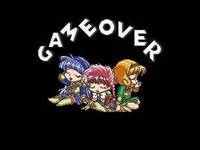|
|

|
PLATFORM
|
SNES
|
BATTLE SYSTEM
|

|
INTERACTION
|

|
ORIGINALITY
|

|
STORY
|

|
MUSIC & SOUND
|

|
VISUALS
|

|
CHALLENGE
|
Very Easy
|
COMPLETION TIME
|
Less than 20 Hours
|
|
OVERALL

|
+ A different take on the MKR storyline
- Very easy, very repetitive combat
- A 1995 Super Famicom game should not look like this
- So easy, items are needless
|
Click here for scoring definitions
|
|
|
CLAMP has enjoyed a lengthy career in the creation of popular manga, with numerous titles to their credit. Their first title to achieve major success was Magic Knight Rayearth, and major successes in the manga world often have corresponding video game adaptations. The Sega Saturn's version of this story was not a great game but managed to be quite entertaining. Released the same year in Japan, the Super Famicom's rendition of Magic Knight Rayearth succeeded in creating a thoroughly generic RPG experience with none of the inventiveness the setting lends itself to. The only remarkable aspect to this version of Magic Knight Rayearth is how it feels much longer than it actually is.
Magic Knight Rayearth's story is that of Japanese middle school students Hikaru Shidou, Umi Ryuzaki and Fuu Houoji being summoned to the land of Cephiro to save its princess from imprisonment. Regardless of the medium, the essentials of this story have remained the same. Though the core remains intact, its telling via manga, anime, and Saturn game version differed in the details, as does this Super Famicom iteration. In particular this version grants a lot of pauses in the narrative to allow for undisturbed level grinding by the girls. Fans of Magic Knight Rayearth will be intrigued by having Ferio, Ascot, Caldina and Rafarga join the girls for awhile in combat. The charm of the original plot carries over to a point, but Magic Knight Rayearth has been given an unfortunately bland rewrite in this adaptation.
Random, turn-based combat is the order of the day in Magic Knight Rayearth. Most of the time the three girls will be by themselves, but they will have help from one of the aforementioned allies at points in the game to take up a fourth party member slot. Turn order is very random, with characters occasionally getting two actions in a row. The usual options for attacking, using magic, defending, using an item, and running are all present in English to make the battles easy to win, even for importers. The only unique twist in battle is the lack of critical attacks identified as such: either a Crushing Attack with double power or a triple power Greatest Attack is seen.
 Don't expect to see this.
Don't expect to see this.
|
|
Combat in Magic Knight Rayearth is very easy. Early on enemies will deal single digit damage to characters with hit points in the triple digits. Later enemies will become more impressive, but Fuu has magic that restores full health to a character for 2 magic points, and she has much more mana than Hikaru and Umi. Points that restore full health are in every dungeon, often more than one. Enemies appear frequently thanks to the high random encounter rate, and they give plentiful experience. They also give money, but thanks to treasure chests yielding more items than will be needed through the game, money is superfluous.
As in the other versions of this story, the girls' equipment upgrades automatically as they advance through the story. A system of having weapons and armor increase in effectiveness through use has its helpfulness quashed by the constant upgrades to them, which resets their growth back to a level of 1. The use of items is somewhat hard to decipher, but they can simply be ignored most of the time thanks to Fuu's healing magic. Nothing is problematic thanks partly to the copious English text in menus, and navigating battles is also highly intuitive.
Magic Knight Rayearth was released in 1995, the year of Chrono Trigger and Seiken Densetsu 3. Compared to other games released for the Super Famicom in that year, this one looks terrible. The girls' sprites do change in battle with each equipment upgrade, but that is the ONLY visual flourish. Environments are bland and static, with nothing moving except Hikaru's sprite. The game outside of battle looks like something from 1992 that lacked much variety in color, and battle animations are boring.
 The bugs of Cephiro are notorious for their insatiable bloodlust.
The bugs of Cephiro are notorious for their insatiable bloodlust.
|
|
The music in Magic Knight Rayearth is thoroughly uninteresting. While not actively unpleasant, nothing of interest will be heard. The seiyuu from the anime utter a few one-syllable vocals that are hard to hear, but these are so few in number that they quickly become boring.
Combat takes up the vast majority of playtime, and Magic Knight Rayearth will still require less than twenty hours to complete unless extreme grinding is done. The challenge is so minimal that it is quite possible to keep pressing the A button and heal after a few battles with no risk. There are no extras in the game, nothing to inspire further play.
Among the many anime adaptations seen by the Super Famicom, Magic Knight Rayearth is probably not the worst. Such faint praise is all that this repetitive and boring game deserves. In comparison with the Saturn's treatment of this material, which also arrived in 1995 for Japan, this version is decidedly inferior. The effort required by ROM hackers to produce a translated version of the game is baffling when their time would have been better served with any number of other projects.
Review Archives
|









